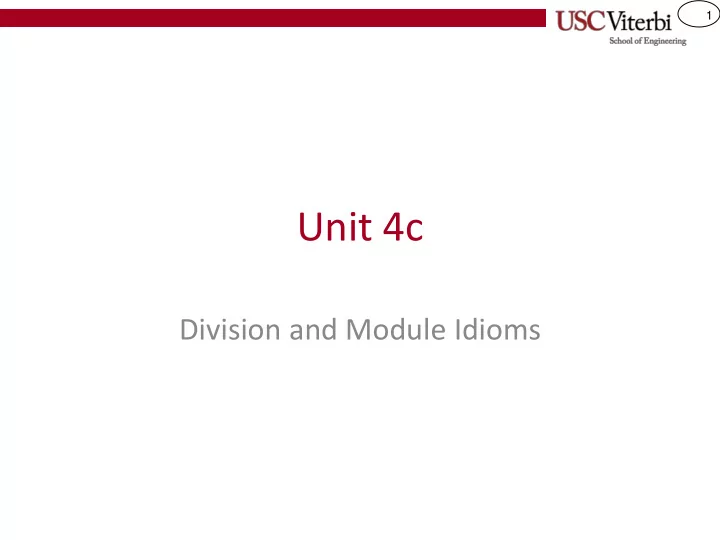

1 Unit 4c Division and Module Idioms
2 Unit Objectives • Apply division and modulo operation to solve specific conversion problems
3 Arithmetic Idioms APPLICATIONS OF DIVISION AND MODULO
4 Integer Division and Modulo Operations • Recall integer division discards the remainder (fractional portion) – Consecutive values map to the same values • Modulo operation yields the remainder of a division of two integers – Consecutive values map to different values – x mod m will yield numbers in the range [0 to m-1] • Example: x 0 1 2 3 4 5 6 7 8 9 10 11 12 13 14 15 0 0 0 0 0 1 1 1 1 1 2 2 2 2 2 3 x/5 0 1 2 3 4 5 6 7 8 9 x 10 11 12 13 14 15 0 1 2 3 4 0 1 2 3 4 0 1 2 3 4 0 x%5
5 Unit Conversion Idiom • The unit conversion idiom can be used to convert one value to integral number of larger units and some number of remaining items – Examples: • Ounces to Pounds and ounces • Inches to Feet and inches • Cents to Quarters, dimes, nickels, pennies • Approach: – Suppose we have n smaller units (e.g. 15 inches) and a conversion factor of k small units = 1 large unit , (e.g. 12 inches = 1 foot) then… – Using integer division ( n/k ) yields the integral number of larger units (15/12 = 1 foot) – Using modulo (n%k) will yield the remaining number of smaller units (15 % 12 = 3 inches)
6 Exercise 1: Unit Conversion Idiom Ex. (Making Change) • Make change (given 0-100 cents) convert to quarters, dimes, pennies • cpp/var-expr/change
7 Exercise 2: Unit Conversion • Suppose a knob or slider 5 generates a number x in the 4 6 3 range 0-255 7 2 • Use division or modulo to 8 1 convert x to a new value, y, in 0=x 255 0=y 9 the range 0-9 proportionally • y = x ___________________ Each of the 10 bins = ______ small units x 0 1 2 3 25 26 51 52 53 255
8 Extracting/Isolating Digits Idiom • To extract or isolate individual digits of a number 957 dec. = 9 5 7. 0 0 100 10 1 0.1 0.01 we can simply divide by the base • Use modulus (%) to extract 957 % 10 = 7 957 / 10 = 95 the least-significant digits • Use integer division (/) to 957 % 100 = 57 extract the most-significant 957 / 100 = 9 digits
9 Exercise 3: Isolating Digits Idiom • Simulate 2 random coin flips producing 2 outcomes (H or T with 50/50 prob.) #include <iostream> • Use rand() to generate a random #include <cstdlib> using namespace std; number. int main() { – rand() is defined in <cstdlib> // Generate a random number int r1 = rand(); – Returns a random integer between 0 and // And another int r2 = rand(); about 2 31 int flip1 = _____________ • Really +2 31 -1 int flip2 = _____________ cout << flip1 << flip2 << endl; – Your job to convert r1 and r2 to either 0 or return 0; } 1 (i.e. heads/tails) and save those values in flip1 and flip2 flip1 = ______________ flip2 = ______________ +2 31 . 0 1 2 3
10 Divisibility / Factoring Idiom • Modulo can be used to 12 % 5 = 2 => 12 is NOT divisible by 5 check if n is divisible by k – Definition of divisibility is if 12 % 3 = 0 => 12 is divisible by 3 k divides n, meaning remainder is 0 • To factor a number we 12 / 3 = 4 can divide n by any of its => 4 remains after => factoring 3 from 12 divisors
11 Challenge Exercise • cpp/var-expr/in_n_days int main() { – Given the current day of the int cday, n; week (1-7) add n days and cin >> cday >> n; int day_plus_n = ______________________; indicate what day of the week (1-7) it will be then return 0; • Write out table of examples } – Input => Desired Output n Day_plus_n n Day_plus_n • Test any potential solution with (assuming (desired) (assuming (desired) some inputs c_day=1) c_day=4) – Cday = 1, n = 2…desired outcome = 3 1 2 1 5 – Cday = 1, n = 6…desired outcome = 7 2 3 2 6 • Plug in several values, especially 3 4 3 7 edge cases 4 5 4 1 5 6 5 2 6 7 6 3 7 1 7 4 8 2 8 5
Recommend
More recommend